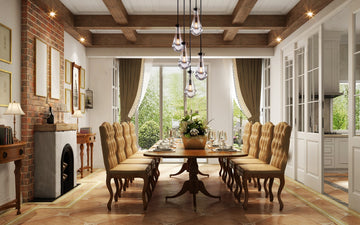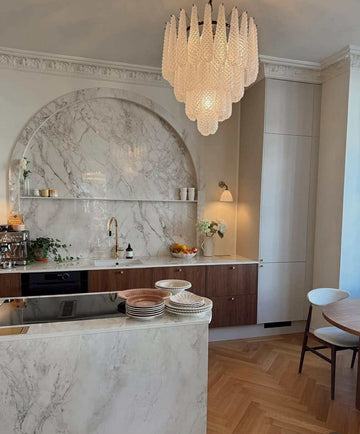A chandelier can instantly elevate the aesthetic of any room, adding elegance, style, and a touch of luxury. However, when it comes to choosing a chandelier, one of the most important factors to consider is the size. A chandelier that’s too large can overwhelm the space, while one that’s too small may not make the desired impact. In this blog, we’ll guide you through how to select the right chandelier size based on the dimensions of your room, the height of your ceilings, and the function of the space.
1. Measure Your Room’s Dimensions
The first step in selecting the right chandelier size is measuring the dimensions of the room where you intend to install it. The size of the chandelier should be proportional to the room’s overall size to ensure a balanced look.
Guideline:
To determine the ideal diameter of the chandelier, add the length and width of the room in feet. The sum should give you a good estimate of the chandelier’s diameter in inches.
For example, for a 12-foot by 15-foot room:
Length + Width = 12 + 15 = 27
Ideal chandelier diameter = 27 inches
This is a general rule, but you can adjust the size based on your personal preference or the room's aesthetic.
2. Consider Ceiling Height
Ceiling height plays a major role in determining the ideal chandelier size. If your ceiling is particularly high, you may need a larger chandelier to fill the space, while a standard or low ceiling might require a more compact design to avoid overwhelming the room.
Standard Ceiling Height (8 feet): For rooms with a ceiling height of about 8 feet, a chandelier should typically hang about 30 to 36 inches above the surface of a dining table or the floor of the room. In terms of diameter, you should stick to the measurement you calculated using the room's dimensions.
High Ceilings (9+ feet): For higher ceilings, a larger chandelier with a longer drop may be required. You can add an additional 3 inches of height for each foot of ceiling above 8 feet. For example, if you have a 10-foot ceiling, you should add about 3 inches to the drop length of your chandelier.
Low Ceilings (7 feet or less): For rooms with low ceilings, it’s important to choose a chandelier that won’t obstruct sightlines or create a sense of crowding. Opt for a more compact or flush-mount chandelier that hangs closer to the ceiling, typically no more than 24 inches below the ceiling.
3. The Function of the Room
The function of the room will also influence the chandelier size. For example, dining rooms often feature larger chandeliers due to the amount of space and the central role the fixture plays in the design. In contrast, entryways, kitchens, and bedrooms may require smaller or more minimalist options.
Dining Room: For a dining room, the chandelier should be centered over the table and have a diameter that’s about half to two-thirds the width of the table. For example, if your dining table is 60 inches wide, your chandelier should be between 30 to 40 inches in diameter. The height of the chandelier should be approximately 30 to 36 inches from the tabletop for an 8-foot ceiling. If your ceiling is higher, you can add extra length accordingly.

Living Room or Great Room: In larger living rooms or great rooms, you can opt for a larger chandelier to fill the space. A chandelier in a living room should be proportional to the size of the room, and it should hang at least 7 feet from the floor. If you’re using a chandelier as the room’s central light source, a larger, more dramatic fixture will make a statement.

Entryway: For entryways or foyers, the chandelier should be large enough to create a welcoming atmosphere but not so large that it feels out of place. Consider a chandelier with a diameter of 20 to 30 inches for a small entryway, while larger spaces can accommodate chandeliers in the 36 to 48-inch range. If you have very high ceilings in the foyer, you can opt for a cascading chandelier that draws the eye upwards.

Bedroom: In bedrooms, the chandelier size should complement the room without overpowering it. A smaller chandelier, typically 18 to 24 inches in diameter, works well above a bed or as a central fixture. For rooms with very high ceilings, consider a chandelier that adds vertical height but doesn’t dominate the space.

4. Layering Lighting
If you’re planning to use your chandelier as the primary light source in a room, consider layering other types of lighting (such as wall sconces, recessed lights, or table lamps) to provide balanced illumination. A chandelier is often most effective when complemented with additional light sources that can fill in the darker corners of the room.
5. Style and Aesthetic
While size is crucial, it’s also important to think about the style of the chandelier. Modern, minimalist designs tend to have cleaner lines and smaller profiles, while more traditional, ornate chandeliers often feature more intricate details and larger sizes. Consider the overall aesthetic of your home and the room in question to ensure the chandelier enhances the design.Conclusion: Find the Right Balance
Choosing the right chandelier size is about finding the perfect balance between functionality and style. By measuring the room, considering ceiling height, and factoring in the function of the space, you can select a chandelier that complements your home and enhances its beauty. Remember, lighting is an essential part of interior design—it’s not just about the illumination but also the mood and atmosphere it creates.
By following these tips and guidelines, you can be confident that your chandelier will be the perfect fit, both in size and style, bringing elegance and warmth to your home.






